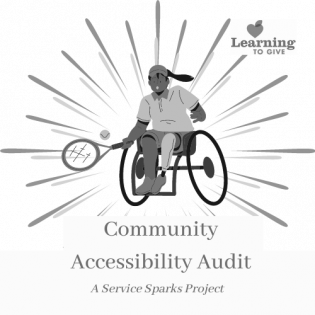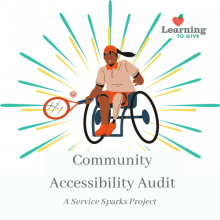Service Sparks: Community Accessibility Audit
Keywords:
Advocacy
Disability
SimpleSafeService
Survey
Ignite meaningful action that lights up the world through "Service Sparks" youth projects! Learn about ways people with different disabilities gain equitable access to places. As you walk through the community look at ways we make places more accessible for people with vision, hearing, or mobility issues. When there is room for improvement, take action to raise awareness of needs.
SERVICE SPARKS
Ignite meaningful action that lights up the world through "Service Sparks" youth projects!
The Americans with Disabilities Act requires that specific standards are met in order to ensure that people with disabilities have equal access to community features. Some are noticeable, and others might not be if you don’t know to look for them. Sometimes buildings and communities don’t meet all of these standards. Doing a community audit (in your school or neighborhood) can help the group identify these accessibility features.
- Learn about the American Disabilities Act requirements that ensure people have fair access to community resource. Talk about why this is fair and important. Look around your school or house and identify things that might not be accessible to a guest in a wheelchair or with reduced vision.
- Take a group walk around the community. Bring a notepad and pen for each walker to take notes.
- Look for features that make the community accessible to people with disabilities. Consider the variety of types of disabilities. Here are some examples of things to look for:
- Curb cuts at intersections
- Both visual and audio indicators at crosswalks
- Functioning door opener buttons
- Wheelchair ramps wherever there are steps
- Elevators in multi-story public buildings
- Accessible bathroom stalls in public buildings
- Playgrounds with accessible features
- Means of entry at public pools
- Based on the group’s findings, talk about where improvement is needed. Discuss how to advocate to community leaders and what to say to raise awareness and take action.
Reflection: Did different parts of your community have more accessibility features than another? Talk about reasons for differences.
Explore more Service Sparks projects:
Learning to Give ...
- educates youth about philanthropy, the civil society sector, and the importance of giving their time, talent and treasure for the common good (knowledge),
- equips youth by encouraging philanthropic behavior and experience (skills), and,
- empowers youth to take voluntary citizen action for the common good in their classrooms, lives and communities (behavior).

